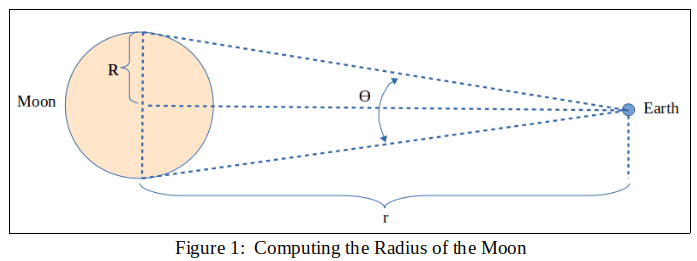This post will show a way to calculate the diameter and radius of the moon. These can be determined from the angular width of the Moon viewed from the Earth and using simple trigonometry.

The following need to be obtained from elsewhere:
r = average Earth-Moon distance = 379800 km (get from solution to one of my previous science posts)
ϴ = Mean value at opposition, measured from the Earth = 1896″ = 0.52670 = 0.009192 radians
(see the NASA Fact Sheets given by the link below)
The following will be calculated:
R = radius of the Moon
D = Diameter of the Moon
Calculate the radius of the moon:
1. From trigonometry we have:
tan(ϴ/2) = R / r
2. Solving for R we get:
R = r * tan(ϴ/2) = (379800 km) * tan(0.009192/2)
R = 1746 km
Calculated value of radius of Moon = 1746 km
Modern value of radius of Moon = 1737 km
Percent difference = .5%
Calculate the diameter of the moon:
The diameter of the Moon is double its radius:
D = 2 * R = 2 * (1746 km)
D = 3491 km
Sources of error:
The sources of error in this approximation are the uncertainty in the values of the average Earth-Moon distance (computed in one of my previous science posts) and the Moon’s mean apparent angular diameter measured from the Earth. Also, it is not clear from the NASA Fact Sheets whether the Moon’s mean apparent angular diameter was adjusted so that it represents an angle “measured” from the center of the Earth. If it is measured from the surface of the Earth then a slight error would be introduced into the calculation of the Moon’s radius.
Source of modern values:
The modern values for the average Moon radius and diameter were gotten indirectly from range measurements taken by LIDAR instruments on lunar orbiting spacecraft. The modern values are given in the NASA Fact Sheets, located at:
https://nssdc.gsfc.nasa.gov/planetary/factsheet/
The notes on the NASA Fact Sheets state the following:
“Note that the values listed on the fact sheets are not “official” values, there is no single set of agreed upon values. They are based on ongoing research and as such are under study and subject to change at any time.
Every effort has been made to present the most up-to-date information, but care should be exercised when using these values.”

